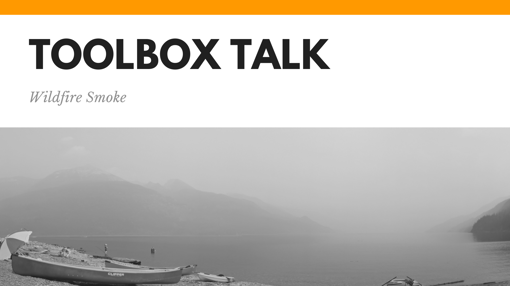
Some of you might have had a similar experience to us this summer where your camping trip has been hijacked by a slight smoky haze due to the wild fires. This above photo was taken at Davis Creek Campground. If you're ever travelling in the West Kootenays, make sure you stop by at this little gem. Over half of the campsites have this waterfront view and 80% of them are first come first serve. Just imagine this photo with clear blue skies, crisp clear turquoise water, and magnificent blue/green mountains.
I never expected the smoke to stay around this long (good thing it's going to clear up for us this weekend). Regardless, at this point, it's been around long enough for us to start realizing the side effects it's having on our health. And, considering the majority of us are working outside this summer, we need to take some precautions to ensure that we keep ourselves healthy.
Below, I've compiled a short summary on the hazards of wildfire smoke and how we can protect ourselves. Please feel free to use this at your next Toolbox Talk.
What is Wildfire Smoke?
Wildfire smoke is a mix of particles and gases containing many different kinds of chemicals. Gases include carbon monoxide, carbon dioxide, and nitrogen oxides. Depending on the material that is burning, the gases could also include other compounds that are carcinogenic.
What are the health effects?
If you have any existing lung or heart conditions, exposure to the smoke may aggravate those symptoms even more. The long term and short term effects of the smoke depends on:
- Level of smoke
- Duration of exposure
- Age
- Current medical conditions
In general, long term health risks (cancer or other chronic health problems) from short term exposure at low or moderate levels, are quite low. So don't feel too overwhelmed with anxiety.
Some symptoms include:
- Irritation of the eyes, nose, and throat
- Headaches
- Worsening of allergies
What can I do to limit my smoke exposure at work?
Most of us work outside, exerting large amounts of physical activity, which is not the best scenario for heavy, smoky days. Here are some ways you can protect yourself:
- Reschedule outside work if possible
- Relocate work to a less smoky area if possible
- Take breaks indoors
- Stay hydrated (to avoid heat stress)
- When driving, keep vents and windows closed, put A/C on re-circulate. Once you get to an area with better air quality, then open the windows to get the CO2 out.
- PPE-If you feel you require more protection, you can wear a respirator. The most common type is the N95 particulate-filtering face piece respirator. Keep in mind that respirators are not the same as masks (i.e surgical masks). Masks are loose fitting and don't have a tight seal that is required. If you do choose to use a respirator, you must be fit tested to them and they have to meet the standards (NIOSH-approved).
What should I do if I experience wildfire smoke symptoms?
If you're experiencing symptoms that you think are related to the smoke, treat it like any other first aid incident and report it to your Supervisor. From there, follow your company procedures for handling first aid.
To see all our other safety blog posts, head to our blog page and select the Safety tag!




